Investigation of Future Land Use Change and Implications for Cropland Quality: The Case of China
Abstract
:1. Introduction
2. Data and Methods
2.1. Data
2.2. Methods
2.2.1. Scenarios Setting
2.2.2. Model Description
2.2.3. Assessing the Effect of Land Use Change on Cropland Quality
2.2.4. Validation of the Model
3. Results
3.1. Model Validation
3.2. Spatial Prediction of Cropland in 2030
3.3. The Prediction of Cropland Quality and Crop Yield
4. Discussion
4.1. Future Changes of Cropland Quantity
4.2. Impacts of Land Use Change on Cropland Quality
4.3. Future Crop Yield Change Induced by Land Use Change
4.4. Uncertainty of the Assessments
5. Conclusions
Author Contributions
Funding
Conflicts of Interest
References
- FAO. The State of the World’s Land and Water Resources for Food and Agriculture; Earthscan Publications: London, UK, 2011. [Google Scholar]
- Deng, X.; Gibson, J.; Wang, P. Management of trade-offs between cultivated land conversions and land productivity in Shandong Province. J. Clean. Prod. 2017, 142, 767–774. [Google Scholar] [CrossRef]
- Bren, D.A.C.; Reitsma, F.; Baiocchi, G.; Barthel, S.; Güneralp, B.; Erb, K.H.; Haberl, H.; Creutzig, F.; Seto, K.C. Future urban land expansion and implications for global croplands. Proc. Natl. Acad. Sci. USA 2016, 114, 8939–8944. [Google Scholar] [CrossRef] [PubMed] [Green Version]
- Tang, J.; Di, L. Past and Future Trajectories of Farmland Loss Due to Rapid Urbanization Using Landsat Imagery and the Markov-CA Model: A Case Study of Delhi, India. Remote Sens. 2019, 11, 180. [Google Scholar] [CrossRef]
- Lasanta, T.; Arnaez, J.; Pascual, N.; Ruiz-Flano, P.; Errea, M.P.; Lana-Renault, N. Space-time process and drivers of land abandonment in Europe. Catena 2017, 149, 810–823. [Google Scholar] [CrossRef]
- Schulp, C.J.E.; Levers, C.; Kuemmerle, T.; Tieskens, K.F.; Verburg, P.H. Mapping and modelling past and future land use change in Europe’s cultural landscapes. Land Use Policy 2019, 80, 332–344. [Google Scholar] [CrossRef]
- Ren, Y.; Lü, Y.; Comber, A.; Fu, B.; Harris, P.; Wu, L. Spatially explicit simulation of land use/land cover changes: Current coverage and future prospects. Earth-Sci. Rev. 2019, 190, 398–415. [Google Scholar] [CrossRef]
- Fondevilla, C.; Colomer, M.À.; Fillat, F.; Tappeiner, U. Using a new PDP modelling approach for land-use and land-cover change predictions: A case study in the Stubai Valley (Central Alps). Ecol. Model. 2016, 322, 101–114. [Google Scholar] [CrossRef] [Green Version]
- Bao, J.; Gao, S.; Ge, J. Dynamic land use and its policy in response to environmental and social-economic changes in China: A case study of the Jiangsu coast (1750–2015). Land Use Policy 2019, 82, 169–180. [Google Scholar] [CrossRef]
- Murray-Rust, D.; Rieser, V.; Robinson, D.T.; Milicic, V.; Rounsevell, M. Agent-based modelling of land use dynamics and residential quality of life for future scenarios. Environ. Model. Softw. 2013, 46, 75–89. [Google Scholar] [CrossRef]
- Liu, J.; Li, J.; Qin, K.; Zhou, Z.; Yang, X.; Li, T. Changes in land-uses and ecosystem services under multi-scenarios simulation. Sci. Total Environ. 2017, 586, 522–526. [Google Scholar] [CrossRef]
- Seto, K.C.; Burak, G.; Hutyra, L.R. Global forecasts of urban expansion to 2030 and direct impacts on biodiversity and carbon pools. Proc. Natl. Acad. Sci. USA 2012, 109, 16083–16088. [Google Scholar] [CrossRef] [PubMed] [Green Version]
- Liu, F.; Zhang, Z.; Zhao, X.; Wang, X.; Zuo, L.; Wen, Q.; Yi, L.; Xu, J.; Hu, S.; Liu, B. Chinese cropland losses due to urban expansion in the past four decades. Sci. Total Environ. 2019, 650, 847–857. [Google Scholar] [CrossRef] [PubMed]
- Fukase, E.; Martin, W. Who will feed China in the 21st century? Income growth and food demand and supply in China. J. Agric. Econ. 2016, 67, 3–23. [Google Scholar] [CrossRef]
- Akbar, T.A.; Hassan, Q.K.; Ishaq, S.; Batool, M.; Butt, H.J.; Jabbar, H. Investigative spatial distribution and modelling of existing and future urban land changes and its impact on urbanization and economy. Remote Sens. 2019, 11, 105. [Google Scholar] [CrossRef]
- Trivedi, H.V.; Singh, J.K. Application of grey system theory in the development of a runoff prediction model. Biosyst. Eng. 2005, 92, 521–526. [Google Scholar] [CrossRef]
- Xu, X.; Du, Z.; Hong, Z. Integrating the system dynamic and cellular automata models to predict land use and land cover change. Int. J. Appl. Earth Obs. Geoinf. 2016, 52, 568–579. [Google Scholar] [CrossRef]
- Trisurat, Y.; Shirakawa, H.; Johnston, J.M. Land-use/land-cover change from socio-economic drivers and their impact on biodiversity in Nan Province, Thailand. Sustainability 2019, 11, 649. [Google Scholar] [CrossRef]
- Tian, G.; Ma, B.; Xu, X.; Liu, X.; Xu, L.; Liu, X.; Lin, X.; Kong, L. Simulation of urban expansion and encroachment using cellular automata and multi-agent system model-A case study of Tianjin metropolitan region, China. Ecol. Indic. 2016, 70, 439–450. [Google Scholar] [CrossRef]
- Samie, A.; Deng, X.; Jia, S.; Chen, D. Scenario-based simulation on dynamics of land-use-land-cover change in Punjab Province, Pakistan. Sustainability 2017, 9, 1285. [Google Scholar] [CrossRef]
- Jia, Z.; Ma, B.; Zhang, J.; Zeng, W. Simulating spatial-temporal changes of land-use based on ecological redline restrictions and landscape driving factors: A case study in Beijing. Sustainability 2018, 10, 1299. [Google Scholar] [CrossRef]
- Verburg, P.H.; Overmars, K.P. Combining top-down and bottom-up dynamics in land use modeling: Exploring the future of abandoned farmlands in Europe with the Dyna-CLUE model. Landsc. Ecol. 2009, 24, 1167–1181. [Google Scholar] [CrossRef]
- Sun, X.; Yue, T.; Meng, W.; Fan, Z.; Liu, F. Effects of land use planning on aboveground vegetation biomass in China. Environ. Earth Sci. 2015, 73, 6553–6564. [Google Scholar] [CrossRef]
- Sahoo, S.; Sil, I.; Dhar, A.; Debsarkar, A.; Das, P.; Kar, A. Future scenarios of land-use suitability modeling for agricultural sustainability in a river basin. J. Clean. Prod. 2018, 205, 313–328. [Google Scholar] [CrossRef]
- Verburg, P.H.; van Berkel, D.B.; van Doorn, A.M.; van Eupen, M.; van den Heiligenberg, H. Trajectories of land use change in Europe: A model-based exploration of rural futures. Landsc. Ecol. 2010, 25, 217–232. [Google Scholar] [CrossRef]
- Verburg, P.H.; Eickhout, B.; van Meijl, H. A multi-scale, multi-model approach for analyzing the future dynamics of European land use. Ann. Reg. Sci. 2008, 42, 57–77. [Google Scholar] [CrossRef]
- Wang, Y.; Li, X.; Zhang, Q.; Li, J.; Zhou, X. Projections of future land use changes: Multiple scenarios-based impacts analysis on ecosystem services for Wuhan city, China. Ecol. Indic. 2018, 94, 430–445. [Google Scholar] [CrossRef]
- Stürck, J.; Schulp, C.J.E.; Verburg, P.H. Spatio-temporal dynamics of regulating ecosystem services in Europe—The role of past and future land use change. Appl. Geogr. 2015, 63, 121–135. [Google Scholar] [CrossRef]
- Jin, T. Effects of cultivated land use on temporal-spatial variation of grain production in China. J. Nat. Resour. 2014, 29, 911–919. [Google Scholar]
- Wang, J.Y.; Liu, Y.S. The changes of grain output center of gravityand its driving forces in China since 1990. Resour. Sci. 2009, 31, 1188–1194. [Google Scholar]
- Song, W.; Pijanowski, B.C. The effects of China’s cultivated land balance program on potential land productivity at a national scale. Appl. Geogr. 2014, 46, 158–170. [Google Scholar] [CrossRef]
- Li, Y.; Li, X.; Tan, M.; Xue, W.; Xin, L. The impact of cultivated land spatial shift on food crop production in China, 1990–2010. Land Degrad. Dev. 2018, 29, 1652–1659. [Google Scholar] [CrossRef]
- Yan, H.; Liu, J.; Huang, H.Q.; Tao, B.; Cao, M. Assessing the consequence of land use change on agricultural productivity in China. Glob. Planet. Chang. 2009, 67, 13–19. [Google Scholar] [CrossRef]
- He, C.; Liu, Z.; Xu, M.; Ma, Q.; Dou, Y. Urban expansion brought stress to food security in China: Evidence from decreased cropland net primary productivity. Sci. Total Environ. 2017, 576, 660–670. [Google Scholar] [CrossRef] [PubMed]
- Wang, C.; Sun, X.; Wang, M.; Wang, J.; Ding, Q. Chinese cropland quality and its temporal and spatial changes due to urbanization in 2000–2015. J. Resour. Ecol. 2019, 10, 174–183. [Google Scholar]
- Liu, L.; Xu, X.; Chen, X. Assessing the impact of urban expansion on potential crop yield in China during 1990–2010. Food Secur. 2015, 7, 33–43. [Google Scholar] [CrossRef]
- Song, W.; Pijanowski, B.C.; Tayyebi, A. Urban expansion and its consumption of high-quality farmland in Beijing, China. Ecol. Indic. 2015, 54, 60–70. [Google Scholar] [CrossRef]
- Lu, X.; Shi, Y.; Chen, C.; Yu, M. Monitoring cropland transition and its impact on ecosystem services value in developed regions of China: A case study of Jiangsu Province. Land Use Policy 2017, 69, 25–40. [Google Scholar] [CrossRef]
- Lin, L.; Ye, Z.; Gan, M.; Shahtahmassebi, A.R.; Weston, M.; Deng, J.; Lu, S.; Wang, K. Quality perspective on the dynamic balance of cultivated land in Wenzhou, China. Sustainability 2017, 9, 95. [Google Scholar] [CrossRef]
- Liu, J.; Xu, X.; Zhuang, D.; Gao, Z. Impacts of LUCC processes on potential land productivity in China in the 1990s. Sci. China 2005, 48, 1259–1269. [Google Scholar] [CrossRef]
- Song, W.; Liu, M. Farmland conversion decreases regional and national land quality in China. Land Degrad. Dev. 2017, 28, 459–471. [Google Scholar] [CrossRef]
- Liu, J.Y.; Liu, M.L.; Zhuang, D.F.; Zhang, Z.X.; Deng, X.Z. Study on spatial pattern of land-use change in China during 1995–2000. Sci. China 2003, 46, 373–384. [Google Scholar]
- Meng, W.; Sun, X. Potential impact of land use change on ecosystem services in China. Environ. Monit. Assess. 2016, 188, 1–13. [Google Scholar]
- Tang, J.; Wang, L.; Yao, Z. Spatio-temporal urban landscape change analysis using the Markov chain model and a modified genetic algorithm. Int. J. Remote Sens. 2007, 28, 3255–3271. [Google Scholar] [CrossRef]
- National General Land Use Planning Outline of China (2016–2030). Available online: http://www.gov.cn/zhengce/content/2017-02/04/content_5165309.htm (accessed on 1 March 2017).
- Jiang, W.; Chen, Z.; Lei, X.; Jia, K.; Yongfeng, W.U. Simulating urban land use change by incorporating an autologistic regression model into a CLUE-S model. J. Geogr. Sci. 2015, 25, 836–850. [Google Scholar] [CrossRef] [Green Version]
- Moulds, S.; Buytaert, W.; Mijic, A. An open and extensible framework for spatially explicit land use change modelling: The lulcc R package. Geosci. Mod. Dev. 2015, 8, 3215–3229. [Google Scholar] [CrossRef]
- Pontius, R.G.; Peethambaram, S.; Castella, J.-C. Comparison of three maps at multiple resolutions: A case study of land change simulation in Cho Don District, Vietnam. Ann. Assoc. Am. Geogr. 2011, 101, 45–62. [Google Scholar] [CrossRef]
- Chen, H.; Pontius, R.G. Diagnostic tools to evaluate a spatial land change projection along a gradient of an explanatory variable. Landsc. Ecol. 2010, 25, 1319–1331. [Google Scholar] [CrossRef]
- Varga, O.G.; Pontius, R.G.; Singh, S.K.; Szabó, S. Intensity analysis and the figure of Merit’s components for assessment of a cellular automata—Markov simulation model. Ecol. Indic. 2019, 101, 933–942. [Google Scholar] [CrossRef]
- Shi, W.; Tao, F.; Liu, J. Changes in quantity and quality of cropland and the implications for grain production in the Huang-Huai-Hai Plain of China. Food Secur. 2013, 5, 69–82. [Google Scholar] [CrossRef]
- Kong, X. China must protect high-quality arable land. Nature 2014, 506, 7. [Google Scholar] [CrossRef]
- Xing, W.; Zhao, Z.; Peijun, S.; Pin, W.; Yi, C.; Xiao, S.; Fulu, T. Is yield increase sufficient to achieve food security in China? PLoS ONE 2015, 10, e0116430. [Google Scholar]
- Koroso, N.H.; Van der Molen, P.; Tuladhar, A.M.; Zevenbergen, J.A. Does the Chinese market for urban land use rights meet good governance principles? Land Use Policy 2013, 30, 417–426. [Google Scholar] [CrossRef]
- Jiang, L.; Deng, X.; Seto, K.C. Multi-level modeling of urban expansion and cultivated land conversion for urban hotspot counties in China. Landsc. Urban Plan. 2012, 108, 131–139. [Google Scholar] [CrossRef]
- Chen, X.; Cui, Z.; Fan, M.; Vitousek, P.; Zhao, M.; Ma, W.; Wang, Z.; Zhang, W.; Yan, X.; Yang, J.; et al. Producing more grain with lower environmental costs. Nature 2014, 514, 486. [Google Scholar] [CrossRef] [PubMed]
- Tian, H.; Lu, C.; Melillo, J.; Ren, W.; Huang, Y.; Xu, X.; Liu, M.; Zhang, C.; Chen, G.; Pan, S.; et al. Food benefit and climate warming potential of nitrogen fertilizer uses in China. Environ. Res. Lett. 2012, 7, 044020. [Google Scholar] [CrossRef]
- Wang, X.; Cai, D.; Hoogmoed, W.B.; Oenema, O. Regional distribution of nitrogen fertilizer use and N-saving potential for improvement of food production and nitrogen use efficiency in China. J. Sci. Food Agric. 2011, 91, 2013–2023. [Google Scholar] [CrossRef]
- Suweis, S.; Carr, J.A.; Maritan, A.; Rinaldo, A.; D’Odorico, P. Resilience and reactivity of global food security. Proc. Natl. Acad. Sci. USA 2015, 112, 6902–6907. [Google Scholar] [CrossRef] [PubMed] [Green Version]
- Wheeler, T.; von Braun, J. Climate change impacts on global food security. Science 2013, 341, 508–513. [Google Scholar] [CrossRef]
- Godfray, H.C.; Beddington, J.R.; Crute, I.R.; Haddad, L.; Lawrence, D.; Muir, J.F.; Pretty, J.; Robinson, S.; Thomas, S.M.; Toulmin, C. Food security: The challenge of feeding 9 billion people. Science 2010, 327, 812–818. [Google Scholar] [CrossRef]
- Zhao, C.; Liu, B.; Piao, S.; Wang, X.; Lobell, D.B.; Huang, Y.; Huang, M.; Yao, Y.; Bassu, S.; Ciais, P. Temperature increase reduces global yields of major crops in four independent estimates. Proc. Natl. Acad. Sci. USA 2017, 114, 9326. [Google Scholar] [CrossRef]
- Cynthia, R.; Joshua, E.; Delphine, D.; Ruane, A.C.; Christoph, M.; Almut, A.; Boote, K.J.; Christian, F.; Michael, G.; Nikolay, K. Assessing agricultural risks of climate change in the 21st century in a global gridded crop model intercomparison. Proc. Natl. Acad. Sci. USA 2014, 111, 3268–3273. [Google Scholar]
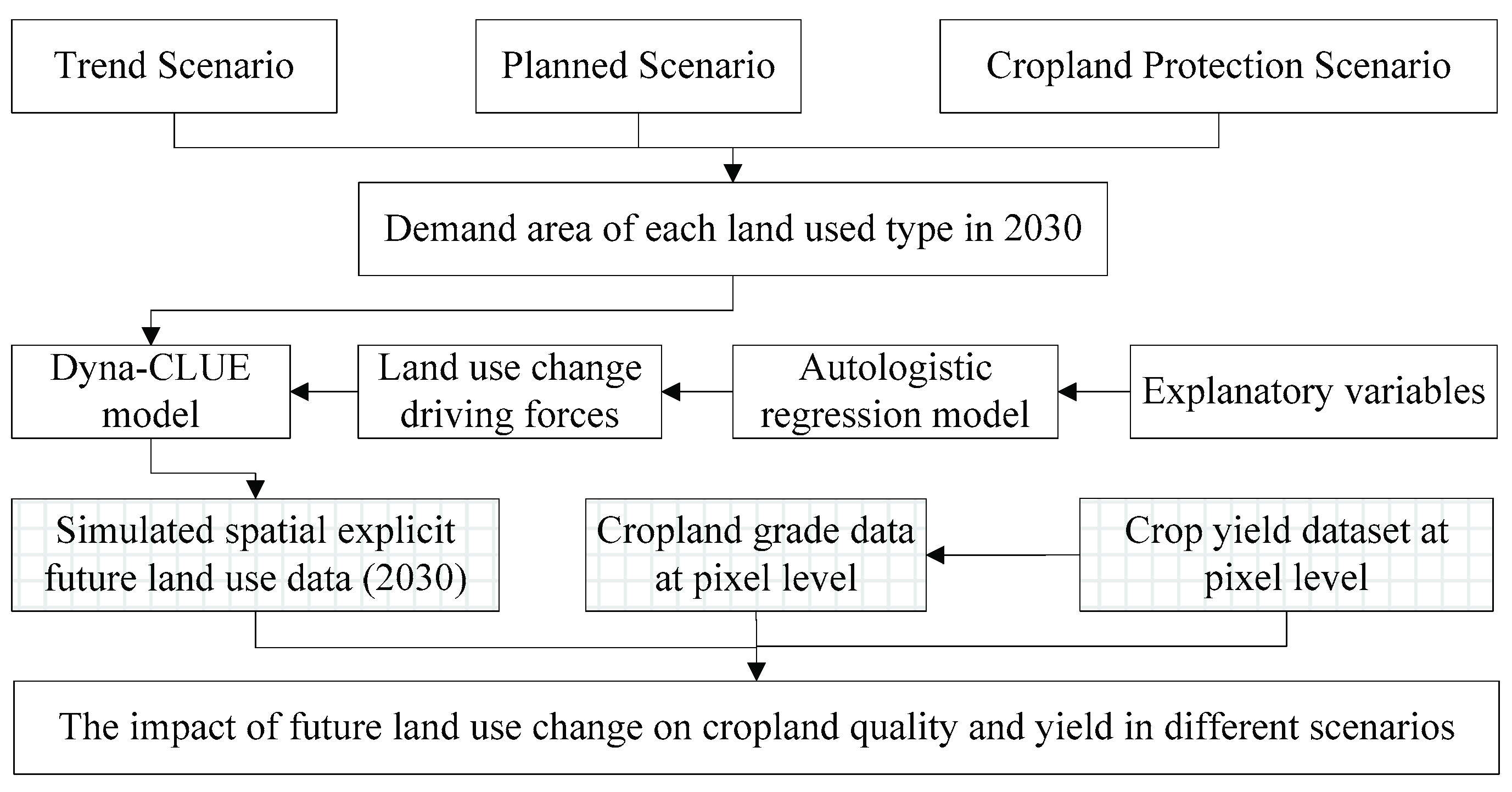
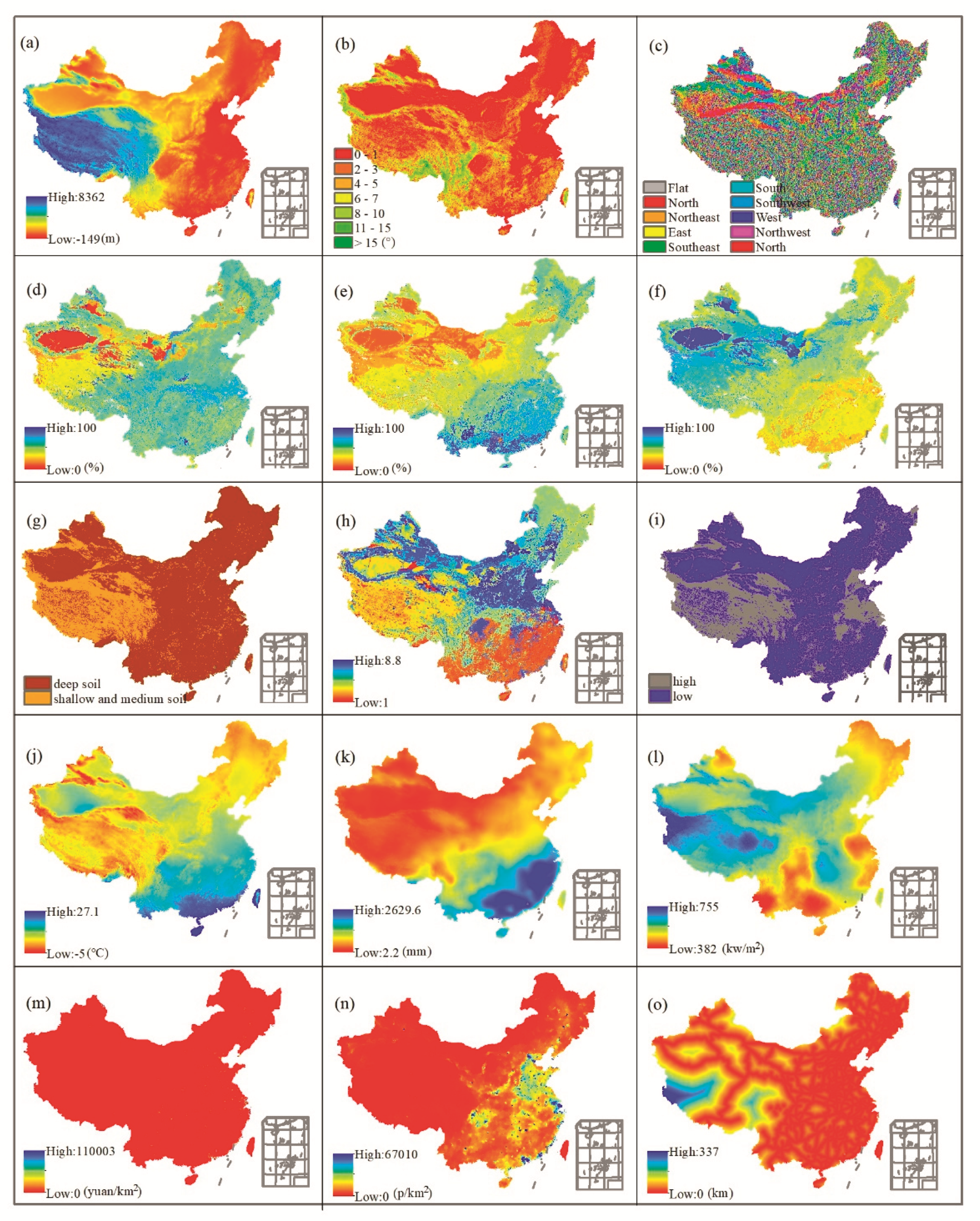
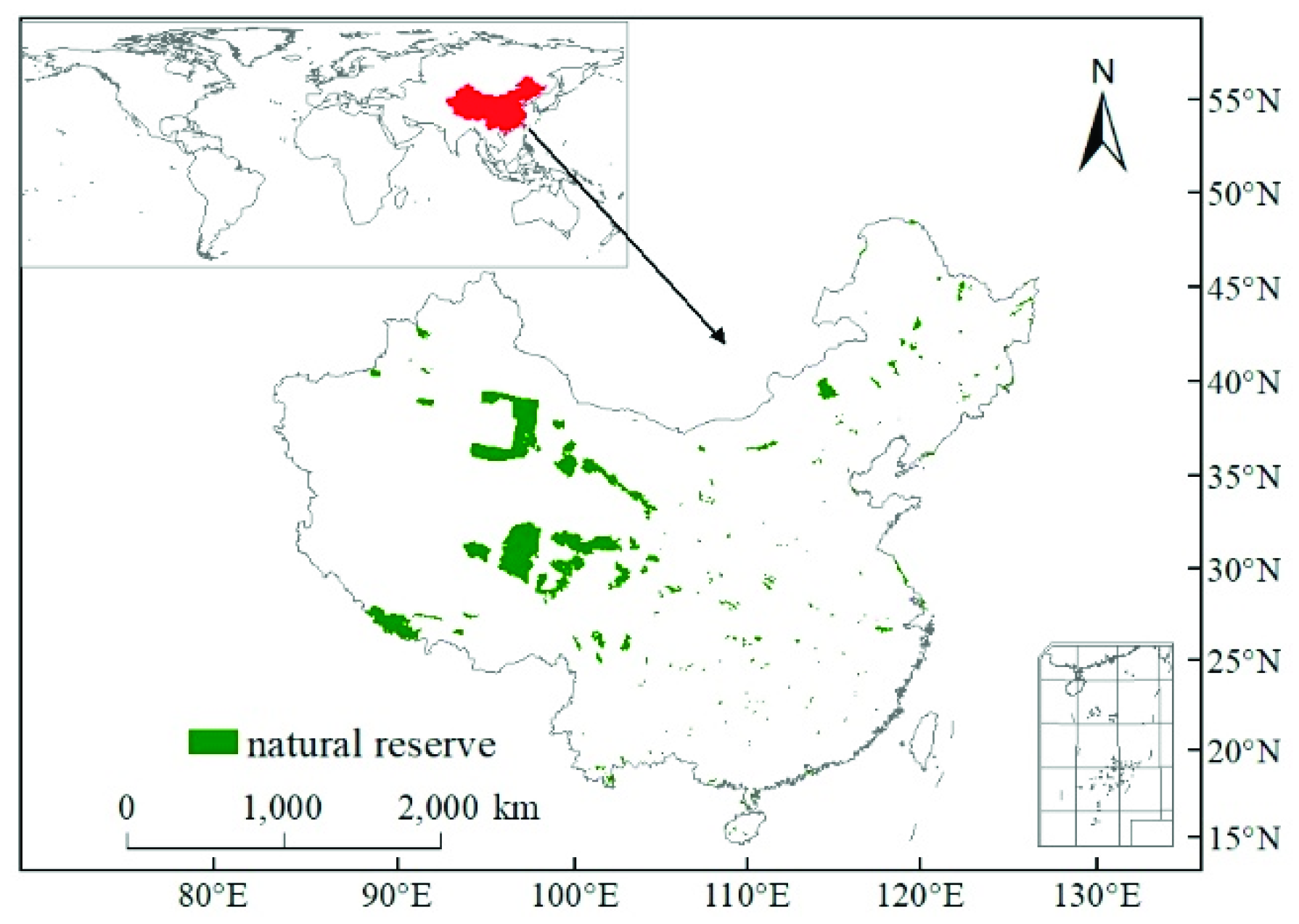

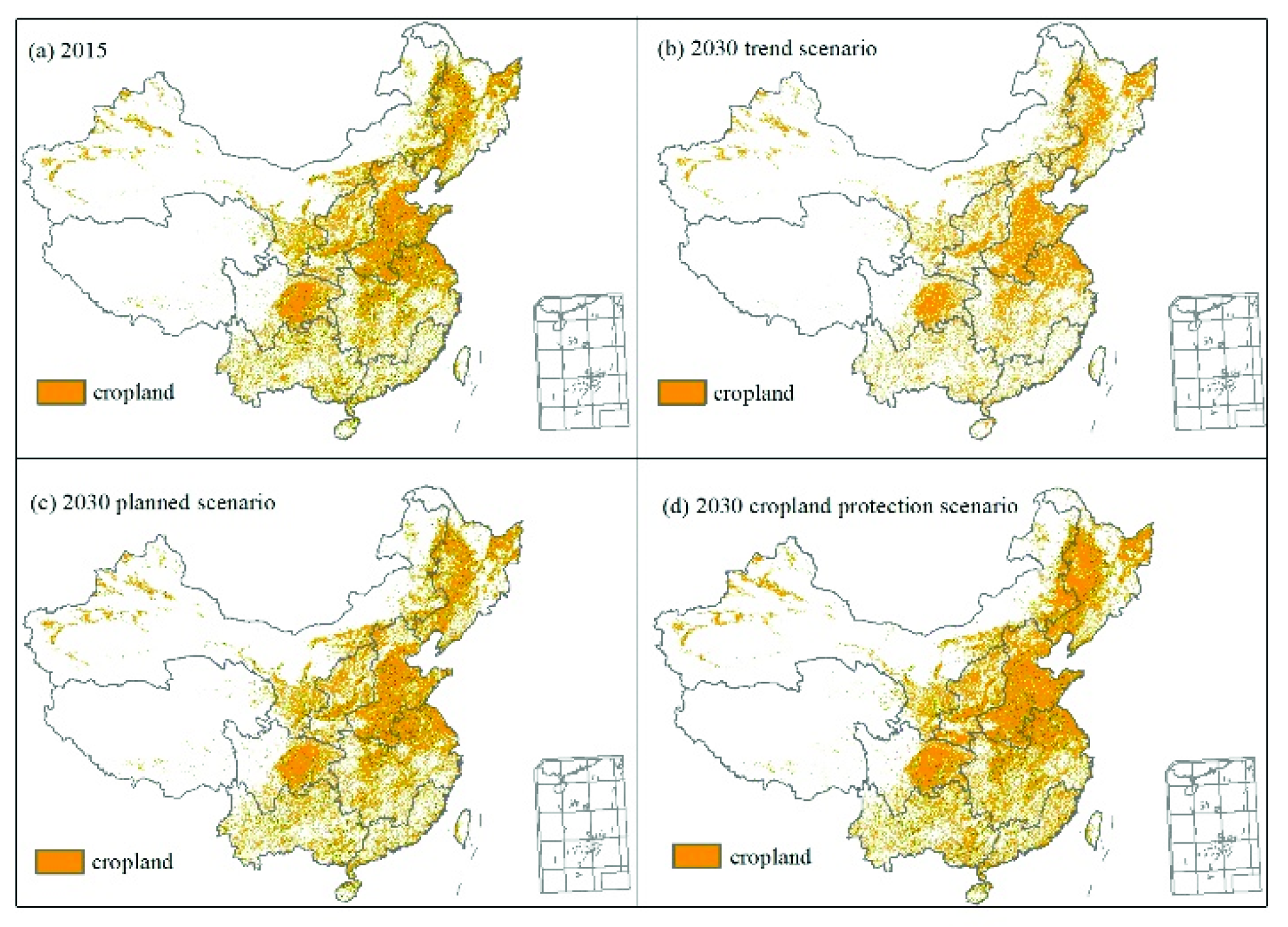




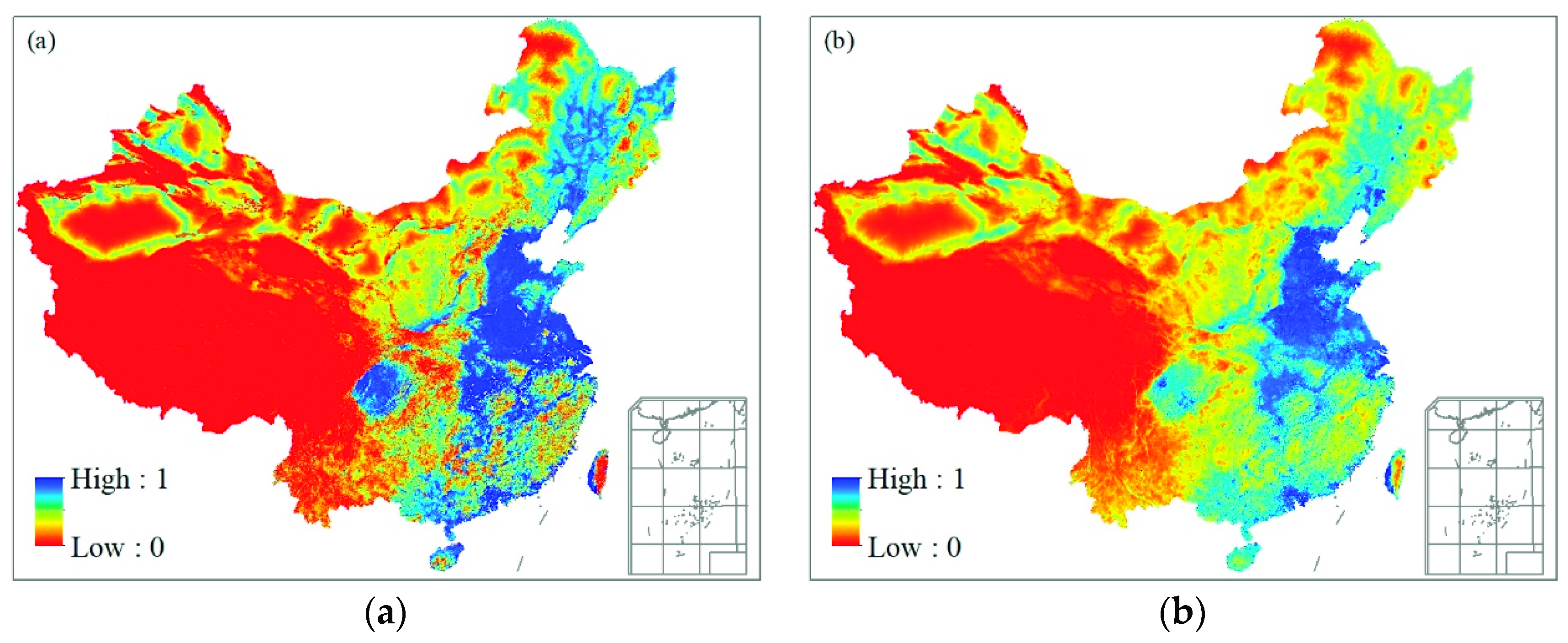
| Scenarios | Cropland | Built-Up | Grassland | Forest | Water Area | Unused |
|---|---|---|---|---|---|---|
| 2015 | 1,780,228 | 216,164 | 2,978,288 | 2,231,256 | 265,568 | 1,980,640 |
| Trend scenario | 1,767,860 | 262,684 | 2,956,316 | 2,229,736 | 270,596 | 1,964,952 |
| Planned scenario | 1,778,857 | 260,112 | 2,976,812 | 2,469,580 | 265,144 | 1,701,638 |
| Cropland protection scenario | 2,067,685 | 216,038 | 2,868,192 | 2,226,214 | 267,180 | 1,806,832 |
| Land Use | Built-Up | Cropland | Grassland | Forest | Water Area | Unused |
|---|---|---|---|---|---|---|
| Built-up | 1,1,1 | 1,1,1 | 1,1,1 | 1,1,1 | 1,1,1 | 1,1,1 |
| Cropland | 1,1,1 | 1,1,1 | 1,1,1 | 1,1,1 | 1,1,0 | 1,1,0 |
| Grassland | 1,18,18 | 1,18,18 | 1,1,1 | 1,1,0 | 1,0,0 | 1,1,1 |
| Forest | 1,18,18 | 1,18,18 | 1,1,1 | 1,1,1 | 1,0,0 | 1,0,0 |
| Water area | 1,0,0 | 1,0,0 | 1,0,0 | 1,0,0 | 1,1,1 | 1,0,0 |
| Unused | 1,1,1 | 1,1,1 | 1,1,1 | 1,1,1 | 1,1,1 | 1,1,1 |
| Variables | Built-Up | Cropland | Grassland | Forest | Water Area |
|---|---|---|---|---|---|
| Slope | −0.003 ** | −0.001 ** | 0.002 ** | −9.0810−4 ** | |
| Elevation | −0.00097 ** | −9.34 × 10−4 ** | 5.32 × 10−4 | −4.74 × 10−4 ** | −6.47 × 10−5 ** |
| Aspect | −3.8 × 10−7 ** | −5.42 × 10−7 ** | −1.19 × 10−7 ** | ||
| Silt soil percent | −2.30786 | −1.33597 | 1.09586 | 1.29462 | |
| Sand soil percent | −2.55572 | −1.48002 | 0.68501 * | 1.67125 | |
| Clay soil percent | −2.64192 | −1.68801 | 0.94395 | 1.83934 | |
| Sallow and medium soil | −1.40601 * | −0.26737 * | |||
| Deep soil | 0.95846 | ||||
| pH | 0.02412 ** | 0.02643 ** | 0.02278 ** | −0.02242 ** | |
| Soil organic carbon | −0.00035 ** | −2.64 × 10−4 ** | 0.00119 ** | 0.00227 ** | |
| High drainage | −0.11215 * | 1.26173 * | |||
| Low drainage | −0.56816 * | −0.6355 * | 0.701 * | ||
| Temperature | 0.00499 ** | −0.00252 ** | −0.00276 ** | −0.01259 ** | −0.00478 ** |
| Precipitation | 8.13 × 10−5 ** | −7.52 × 10−5 ** | 2.53 × 10−4 ** | 6.32 × 10−5 ** | |
| Radiation | 1.35 × 10−6 ** | 8.45 × 10−7 ** | −2.41 × 10−6 ** | −2.88 × 10−6 ** | 2.10 × 10−6 ** |
| GDP | 0.00006 ** | 2.04 × 10−5 ** | −5.17 × 10−5 ** | −3.00 × 10−5 ** | 6.74 × 10−5 ** |
| Distance to main roads | −5.68 × 10−7 ** | −4.02 × 10−6 ** | 6.01 × 10−6 ** | −9.12 × 10−6 ** | −2.36 × 10−6 ** |
| Population | 0.00068 * | 2.00 × 10−4 ** | −8.00 × 10−4 ** | −6.20 × 10−5 ** | −4.38 × 10−4 ** |
| ROC | 0.92 | 0.93 | 0.81 | 0.91 | 0.80 |
| Agricultural Zone | 2015 | 2030 Trend Scenario | 2030 Planned Scenario | 2030 Cropland Protection Scenario | ||||
|---|---|---|---|---|---|---|---|---|
| Amount (kg × 1010) | Percentage * (%) | Amount (kg × 1010) | Percentage (%) | Amount (kg × 1010) | Percentage (%) | Amount (kg × 1010) | Percentage (%) | |
| NEP | 13.62 | 18.63 | 13.61 | 18.65 | 13.62 | 18.63 | 14.82 | 18.90 |
| NASR | 6.99 | 9.57 | 6.98 | 9.57 | 6.99 | 9.57 | 7.63 | 9.73 |
| HHHP | 20.15 | 27.57 | 20.15 | 27.62 | 20.15 | 27.56 | 21.60 | 27.53 |
| LP | 3.75 | 5.13 | 3.74 | 5.13 | 3.75 | 5.13 | 4.29 | 5.47 |
| QTP | 0.13 | 0.18 | 0.11 | 0.15 | 0.13 | 0.18 | 0.13 | 0.17 |
| MLYP | 5.63 | 7.71 | 5.63 | 7.72 | 5.63 | 7.71 | 5.87 | 7.48 |
| SBSR | 18.57 | 25.41 | 18.48 | 25.33 | 18.58 | 25.41 | 19.26 | 24.56 |
| YGP | 2.78 | 3.81 | 2.77 | 3.79 | 2.77 | 3.80 | 3.11 | 3.97 |
| SC | 1.45 | 1.99 | 1.48 | 2.03 | 1.48 | 2.02 | 1.71 | 2.19 |
| Sum | 73.08 | 100 | 72.95 | 100 | 73.10 | 100 | 78.44 | 100.00 |
© 2019 by the authors. Licensee MDPI, Basel, Switzerland. This article is an open access article distributed under the terms and conditions of the Creative Commons Attribution (CC BY) license (http://creativecommons.org/licenses/by/4.0/).
Share and Cite
Wang, M.; Sun, X.; Fan, Z.; Yue, T. Investigation of Future Land Use Change and Implications for Cropland Quality: The Case of China. Sustainability 2019, 11, 3327. https://doi.org/10.3390/su11123327
Wang M, Sun X, Fan Z, Yue T. Investigation of Future Land Use Change and Implications for Cropland Quality: The Case of China. Sustainability. 2019; 11(12):3327. https://doi.org/10.3390/su11123327
Chicago/Turabian StyleWang, Meng, Xiaofang Sun, Zemeng Fan, and Tianxiang Yue. 2019. "Investigation of Future Land Use Change and Implications for Cropland Quality: The Case of China" Sustainability 11, no. 12: 3327. https://doi.org/10.3390/su11123327





